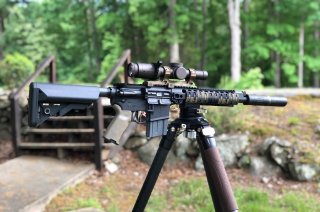LMT’s Confined Space Weapon: The Ultimate Combat Rifle?
But such performance comes at a price.
Key point: This weapon packs a punch while also being maneuverable. Here is why the military wants it.
While Sig Sauer, Inc. won the U.S. SOCOM’s Suppressed Upper Receiver Group (SURG) trials, we are starting to see some of the other weapons that competed against it. One of them is LMT’s Confined Space Weapon (CSW), a futuristic-looking rifle that utilizes unique design elements. But how does the CSW solve the SURG problems differently from Sig Sauer, Inc.’s submission? Could it go on to serve elsewhere?
This first appeared in 2019 and is being reposted due to reader interest.
The standout feature on LMT’s CSW is the handguard. As with many other of LMT’s rifles, it’s monolithic, with the rail being mated to the upper receiver in one piece for increased strength. But it also extends all the way to the tip of the suppressor, completely shrouding both the weapon and the suppressor. The reason for this is heat mitigation.
Anyone who has shot a suppressed weapon knows that suppressors heat up, fast. This is due to what they do: they manage and control the release of hot combustion gases. In doing that, a lot of the temperature in the gas is transferred to the suppressor itself.
This can make suppressors dangerous to work around. Hot suppressors can burn skin and melt clothing and plastics. The requirements in the SURG contract addressed this point directly, one of the requirements was that contact burns had to be prevented, with a contact burn being defined as a peak temperature of over 160 degrees Fahrenheit in a one-second contact, after firing 210 rounds in 7 minutes at a rate of one round every two seconds.
While Sig designed an interesting skeletal suppressor cover to meet this requirement, LMT figured the best solution was simply enclosing the suppressor within the handguard of the rifle. The air gap between the suppressor and the rifle prevents the handguard from heating up as fast as the suppressor, and thus prevents contact burns.
The suppressor itself is also of innovative design. Lawrence Livermore National Laboratories investigated ways to improve suppressor technology and came out with the “Virtual Baffle System” which is used in CSW’s suppressor. The new system supposedly decreases backpressure, making the gun more reliable, with less gas expelled back at the shooter’s face.
The rest of the rifle is fairly standard, apart from the stock. It has a standard ambidextrous LMT lower receiver with the mirrored bolt catch and a .300 Blackout bolt. The reduced length stock and buffer assembly are interesting, they are about as short as they can get while still being functional with a standard length bolt carrier group. The miniature SOPMOD-style stock used on the CSW has also been seen on some NGSW prototypes.
LMT describes the CSW as an ideal rifle for close-quarters battle, due to its compact dimensions, powerful subsonic .300 Blackout chambering, and shrouded suppressor. But the package doesn’t come cheap. LMT prices the rifle at around 4,000 USD.
Charlie Gao studied Political and Computer Science at Grinnell College and is a frequent commentator on defense and national security issues. This first appeared in 2019 and is being reposted due to reader interest.
Image: Reuters

